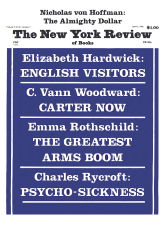In response to:
Sign Language from the January 24, 1980 issue
To the Editors:
Though I commend Mr. Donoghue for his careful review of John Ashbery’s As We Know (NYR, January 24), I must object to his reading of “Litany,” the collection’s major poem. Mr. Donoghue says of “Litany”: “how you read it is up to you”; however, the poet has prescribed a reading which turns out to be a performance: “The two columns of ‘Litany’ are meant to be read as simultaneous but independent monologues” (Author’s note). The question, of course is: How does the silent, solitary reader duplicate this aural sensation? The method which Mr. Donoghue rejects as “perverse” is, I contend, the only way to read the poem: namely, to alternate between one column and the next. Thus, the reader starts with column A, reads a number of stanzas, stops at a natural break, then switches (going back) to column B. Since the columns are not symmetrical, the reader can never “catch up.” Instead, he will either lag or advance. Further, unless he mechanically (and defeatingly) mark his progress through the text, he will continuously have to re-read the tail-end of what he has, moments before, read. This alteration and this repetition are fundamental to any litany. In this case, they further mirror “Litany” ‘s dominant images—overlapping waves and wavering lines.
Later, Mr. Donoghue, in discussing Mr. Ashbery’s comment that he wanted poetry to do what painting does, pokes fun at the poet for “forgetting that a painting doesn’t talk.” Mr. Donoghue’s observation is not as self-evident as he assumes. If a reader reads by translating a block of print into a poem, a viewer sees by translating blotches of paint into a painting. Economy and convention dictate that we read a poem on two axes (west-east, north-south); on the other hand, the viewer in front of a painting reads in circles: he sees (and hears) everything at once. To read “Litany” as form, title, and author prescribe is to read it as a painting, for the reader will move not horizontally or vertically, but forward and backward. As the line then becomes a spiral, space turns into time.
As We Know is spellbinding: hilarious, brilliant, beautiful, true. John Ashbery is a poet privileged to have had as many breakthroughs as he has had books. “Litany” is another tour de force; accordingly, it will take readers a while to catch up, for, to paraphrase Arnold Bennett, “We do not measure a great work of art; it, rather, measures us.”
Maureen Bloomfield
Cincinnati, Ohio
Denis Donoghue replies:
I gather that Ms. Bloomfield is pointing toward some possibilities in the reading of post-Modernist poems, but I don’t think her direction helps in this particular case. How you read Ashbery’s “Litany” is still up to you, because you are free to make what you like of his note that the two columns of the poem “are meant to be read as simultaneous but independent monologues.” The problem in alternating between one column and the next (why is the right-hand one called “the next,” by the way?) is this: what constitutes “a natural break”? Neither of the columns indicates such a thing. There is no reason to decide that one gap between blocks of print is privileged over another. The bottom of the page is rarely a break, since many sentences run over into the next page. If you stop at any point before page 16 you have merely exercised your freedom to do so. Litanies don’t help. You don’t recite a litany by moving “forward and backward,” you utter one phrase and then the next in the order as given: “Ark of the Covenant”: “Gate of Heaven”: “Morning Star”: “Health of the Sick”—and so on, if I have recalled that particular litany accurately.
On Ms. Bloomfield’s second point: I have never felt obliged, looking at a painting, to “read” it in circles. I read it as the lines of force seem to suggest.
Finally (and not at all incidentally): nothing in my review of Ashbery’s book could reasonably be construed as poking fun at it or at him.
This Issue
April 3, 1980



